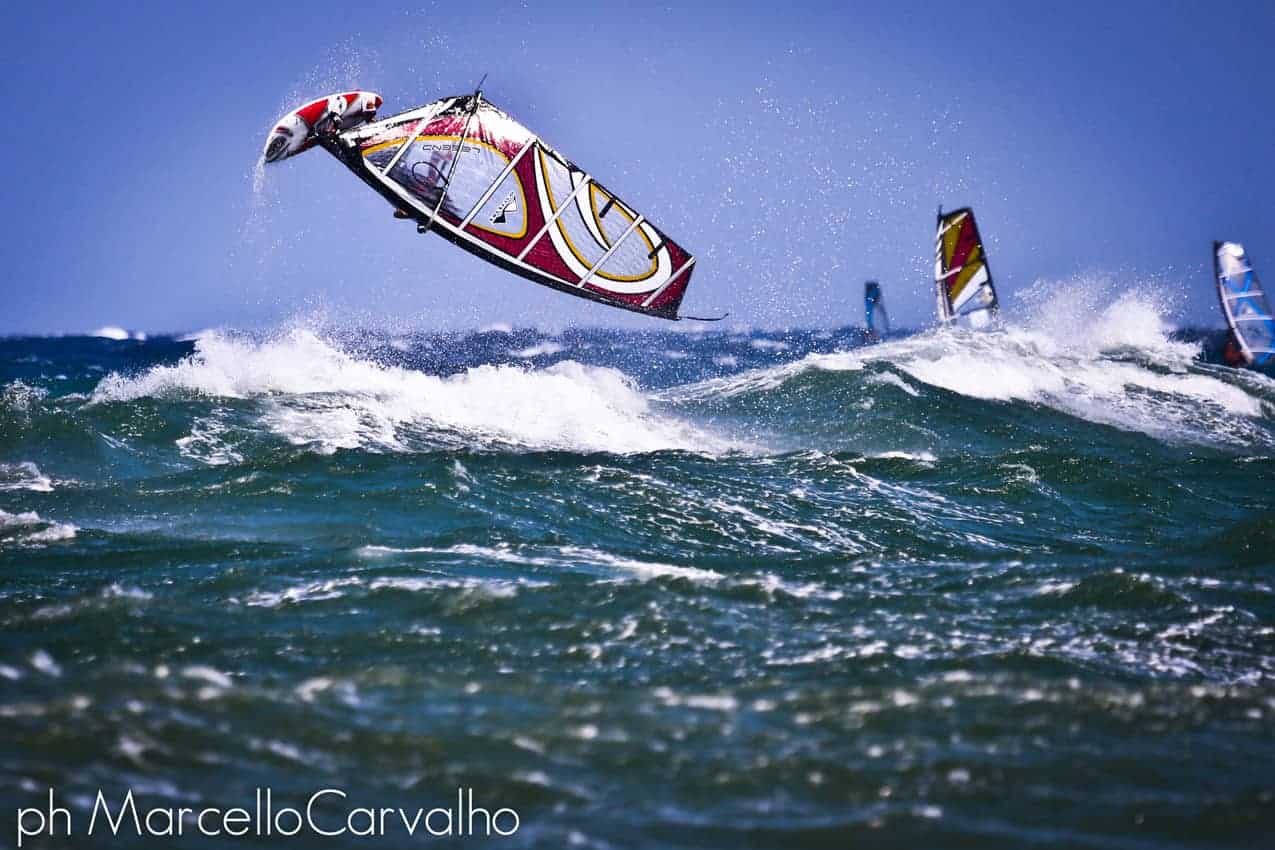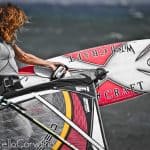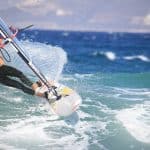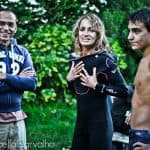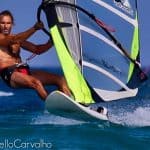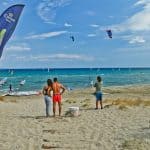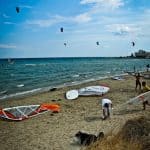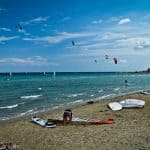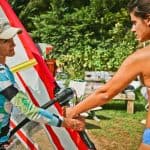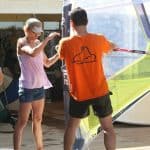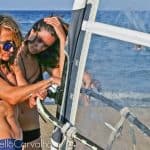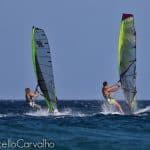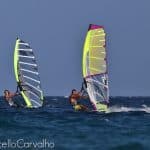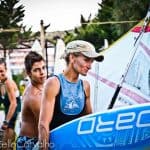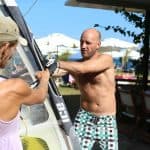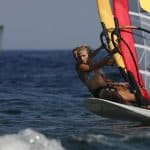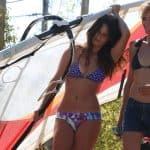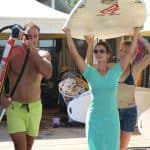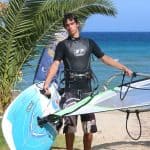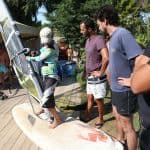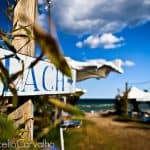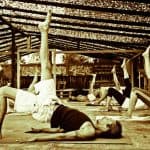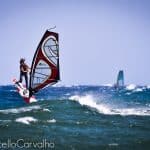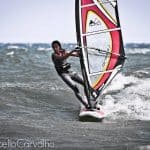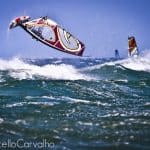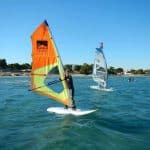Here is what I also like: Windsurfing. To learn it properly you need to be guided by a pro. And Tony Frey -as a pro- has some amazing tips for windsurfing. Read what she says.
What is the easiest way to learn windsurfing?
Learning windsurfing alone is really difficult. It is very important for a beginner, in order to make a good windsurfer out of him, the choices he/she makes about the style adopted, the choices he/she makes in regard to his/her equipment and the maneuvers he/she practices.
A beginner may find these tips here very useful:
- Start with a big board (a 200litre 220litre one). Use the smallest sail possible. A 3m sail (special beginner sail) is a a good one to start.
- You definitely need to properly learn how to change direction while planning. You need to learn tacking (turning towards the wind) and Jibing ( going away from the wind) and you need to learn them properly.
- Beginners should learn how to tack as soon as they step on the board in a consistent and right way. Progress and understanding on how board and sail work with the wind will come up gradually as you practice. You will gradually make clear how the techniques work and have no doubt about them. You can ask questions on why things happen “this or that” way. By asking you will learn the solutions. There is a solution for everything.
- When you learn how to tack, then you will move to jibing. The right way to learn how to jibe consists of a specific process and steps, through which you will also master this. There are 2 types of jibing: The slow and the fast one. You will learn them both on 200L or 220l boards, with a 3 mt. sail.
- After learning all techniques properly you will move to a smaller board, though still keeping the small sail (3 mt).
Congratulations! Now that you are in full control of the turning techniques you will change to a 4 mt sail. In this phase you will also learn how to put on the harness. First you will learn it on the beach along with the theory on what to do if you fell in the sea with the sail being over/under you. You practice regarding harness will take place with light winds in order to feel comfortable with it and grasp it.
After feeling comfortable using this equipment , the board should change to a ca. 160l with a 4m sail. Changing sails will be possible now, but only up to 5m. Now you are ready to buy your own equipment!!! Not Before!!
To summarize these windsurfing essentials. Planning the board means to:
- being able to control the board in such a way that the nose of the board tips out of the water
- having the sensation that the board is sliding over the surface of the water over high speed
Planning is not difficult and you will enjoy the process every time by having this nice feeling of achievement! The more difficult part is to learn how to turn (jibe, tack). Focus on these 2 and all the rest will fall in place. Practice will make you perfect!
Learning how to turn and learning planning, you will be able to windsurf in all conditions and tackle all unexpected conditions. The whole process – if you practice 2 times per week- will take you 3-4 months.
A good advice is not to windsurf in the same places. Change locations, get in to chop water and more radical conditions. This will make you faster a better and stylish windsurfer!!
What Tony suggests
Apart from individual lessons you can get a 10 lessons package (20+ hours) for 250 euro. Here are the details of this package, which are a lesson by themselves actually.
LESSON 1-2
BASIC STEPS: theory simulator, balance, body position, turning with beginner tack, steering ,
Starting with simulator is very important to understand your first steps. Learning the right position, putting in order your steps on the board, and make you feel how it is standing on the board. Talking about how a windsurf board works with the wind, the safety rules and describing you, few things about the equipment. When getting into the water and standing for the first time on the board, will be impossible doing the right steps as on the simulator straight away. That’s why we choose as charm condition as possible, and gear that is suitable for each student. As time pass, you will feel more and more comfortable with your balance and it will be possible listen to the teachers orders. From the first lesson you can stand up on the board and get your first feeling how windsurfing can be. Of course there is still a whole world of experience waiting for you, that will make this sport very interesting.
LESSON 3-4
TECHNIQUE CORRECTION: learning how to turn ( tacking) with less steps, entering and exit in the same place ( learning upwind), getting into better style, theory of lesson 1-2 is getting more clear. Depends on weight and progress, equipment can be changed, into smaller board and bigger sail.
We are ready to make some certain correction and not treat you as a total beginner anymore. The technique for small boards is very important to be learned on the big boards, that’s why we get into details in turning (tacking)and steering the board. Steps must be more clear, correct and faster. For this case we use once in a while the simulator again, for understanding and discussing every detail. First it must be clear in the head, then it can be clear on the water. Equipment must be changed (depends always on weight and level of the student), and wind will be used as well correctly. On the 4th lesson the feeling of windsurfing is getting stronger, at this moment you can understand if windsurfing can get into your life or you just leave it. You understand how much effort you need to pass every difficulty and corrections of your technique.
LESSON 5-6
TECHNIQUE FOR SMALL BOARDS: learning how to turn faster ( fast tacking) steering board with extremer way, first steps for the second turn called jibing ( downwind stearing).
When the equipment changes into smaller boards and bigger sizes of sail, mistakes will not forgiven so easy. When the weather condition changes into stronger wind as usual and in to choppy water ( not flat), as well mistakes will not forgiven so easy. The better balance you get, of the hours you are On the water, the better you get with the technique we are offering you. Everything is about good style and correct steps. You don’t need force to do a fast and clean tack with wind, or even steering down wind and getting into the jibe. Its all about how you do it and this is going to be your training most of the time at this lessons. Training by yourself and making your own experience, ( mistakes) is very important for understand the correct way. We need your mistakes and your expierence to go on ….
LESSON 7-8
TRYING YOURSELF: beach start, getting into stronger winds, into harder water condition, learning on simulator first steps of the seconds turn ( jibing)
Beach start is a way to stand on the board without pulling the sail up with your hands. With beachstart you learn the technique, how you can get out of the deep water, too. its really easy getting a beach start done, that’s why also there we use some movements that makes it more difficult, but will help you learning faster the waterstart ( getting out of the deep water without using a rope) .
Windsurfing can be done in any condition now with extremer way. You can feel the speed your board can get, you will feel more comfortable, and you will not forgive yourself easy anymore when making mistakes. You will get stricter in your windsurfing, and this will make your level grow. Jibing (turning downwind) , will be on plan , if the weather condition is correct. For jibing we need light winds ( max. 14knots) and changing again into a bit bigger boards, for be able concentrating on the new technique.
LESSON 9-10
JIBING & HANGING: jibing on simulator and water, filming + analyze technique on video.
Training on Jibing and tacking will always be on the plan from now. Every weather condition has his certain way, how to do it. Everything will be discussed before entering the water. Any question will be answered so it will get clean in your head. Every time entering the water, you must learn something new. As a beginner you must think always before doing, nothing will happen from alone. Filming in between your lesson will give you 100% the truth about your style and your mistakes. Analyzing it parallel, will dessapear any doubts!! After 10 lessons we will check your level and see where you are standing and how your future on this sport can look like. You will be able understanding a lot of things by yourself, after this whole experience you had. Choosing a very small board that is not for your level, can destroy your whole technique in your turns (jibing tacking). So be careful on your choices, and keep turning this board well, until it will happen without your mind….
Good luck!!!!
Keep in mind that the whole and progress depend on your concentration and how much you actually try and care and get over your fears along with the lessons proximity. You need to practice once or twice per week and not to leave huge gaps between lessons (i.e. practicing every 2-3 weeks). Do that and progress in windsurfing will come fast!
The philosophy behind windsurfing
Some chant mantras, attend ashrams, go to lectures, others go through some extreme physical or body alterations and others simply depart from society and enter a monastery of some kind or of some religion. Many people seek ways to find themselves and understand life!
However there are different spiritual texts that point to this: self observation and understanding of self happens every time, every where. There comes the windsurfing part.
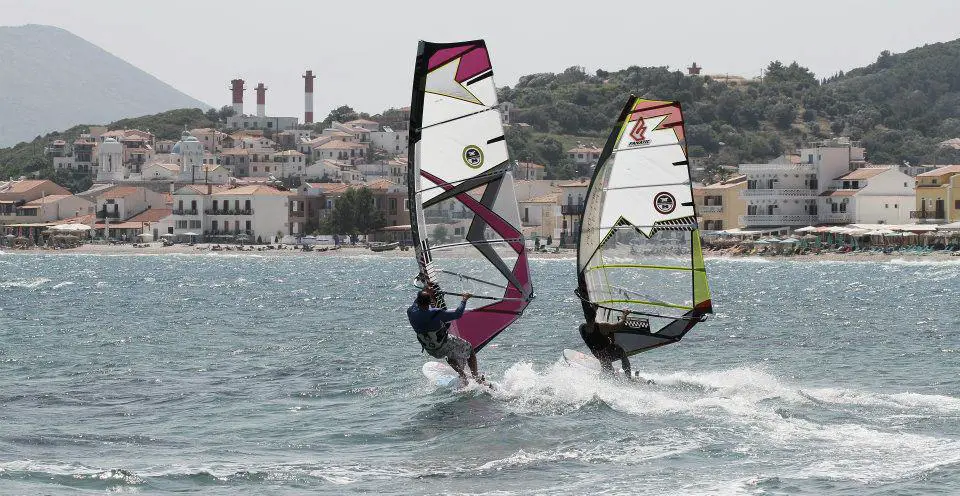
If someone told me a few years ago that you can find hundreds of different aspects of the micro elements that consist the personality of someone while getting on and off from a board I would say… hmmm, are you sure? i I mean its fun, it’s a sport and that is all.
All these are theory until the moment you start learning how to surf. First you need a teacher. A good one if you want to learn things right, otherwise you will waste lots of time doing things wrong. The good teacher will help you to stand properly, hold properly, teach you about the wind and how to sail. He will correct you but not stand in your way. He will help you to find your path and style but will not try to impose his own preferences to you.
Sounds familiar so far? Either Yes or No, keep reading.
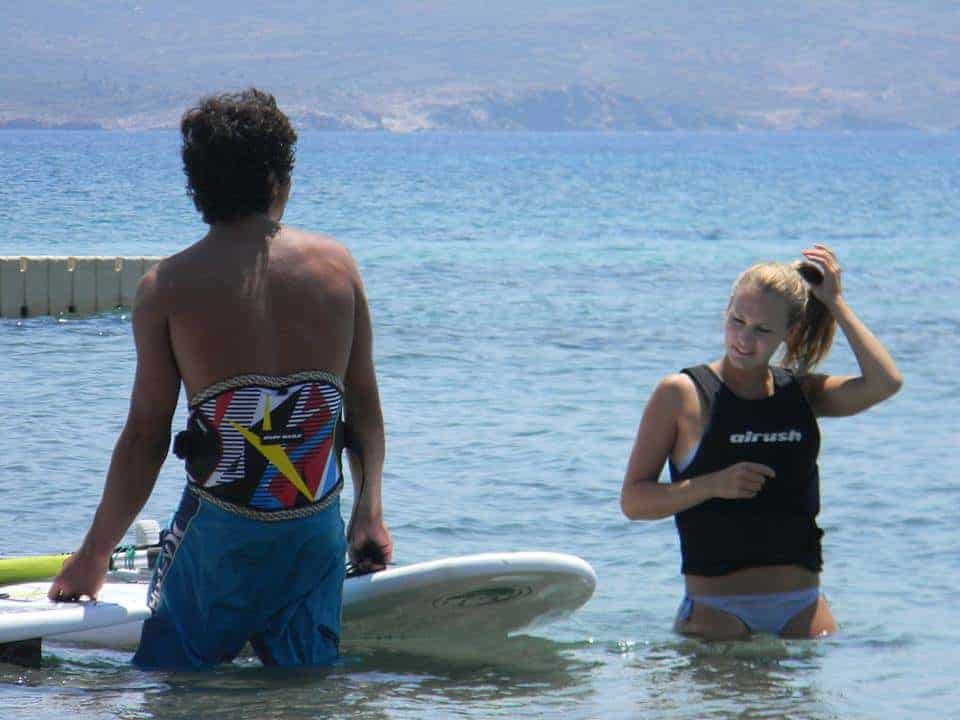
Now, have you ever been on a board trying to balance and control the board using little or strong wind along with lack or too many waves? Oh, the huge number of times you will fall down in shallow or deep and you will have to ride the board again, pick up the heavy sail and point the board with the wind behind you but in the right angle in order to have mere motion or huge thrust? The many times you will don’t know how to change course, fall down again, stand up, try to apply different ways to turn, then fall and then climb up, swallowing water, cursing getting angry and… having fun.

Isn’t this the same as the currents and turbulence’s of life indeed, where you try to find your purpose and path, when you try different ways, you fall and stand up again, trying different ways to move and cope with things and difficulties, with successes and failures?
Remember one or some of your successes? Remember the feeling or “sailing” fast in life with things pushing you to the right direction, with the “wind” of luck and opportunity on your sail? Where you were holding the steer of life “board”, where you tried to take that new “turn”, new opportunity, you feel and climbed up again.
Remember the combination of proper wind, skill and self reliance along with the confidence that lifted your life “board” from the water and you moved in incredible speeds with your eye at the horizon or better to say at you future?
Remember how you didn’t hold the sail properly and you were moving slow, not being able to catch that wind. What happened when you were able to find that “right angle”? You flew!
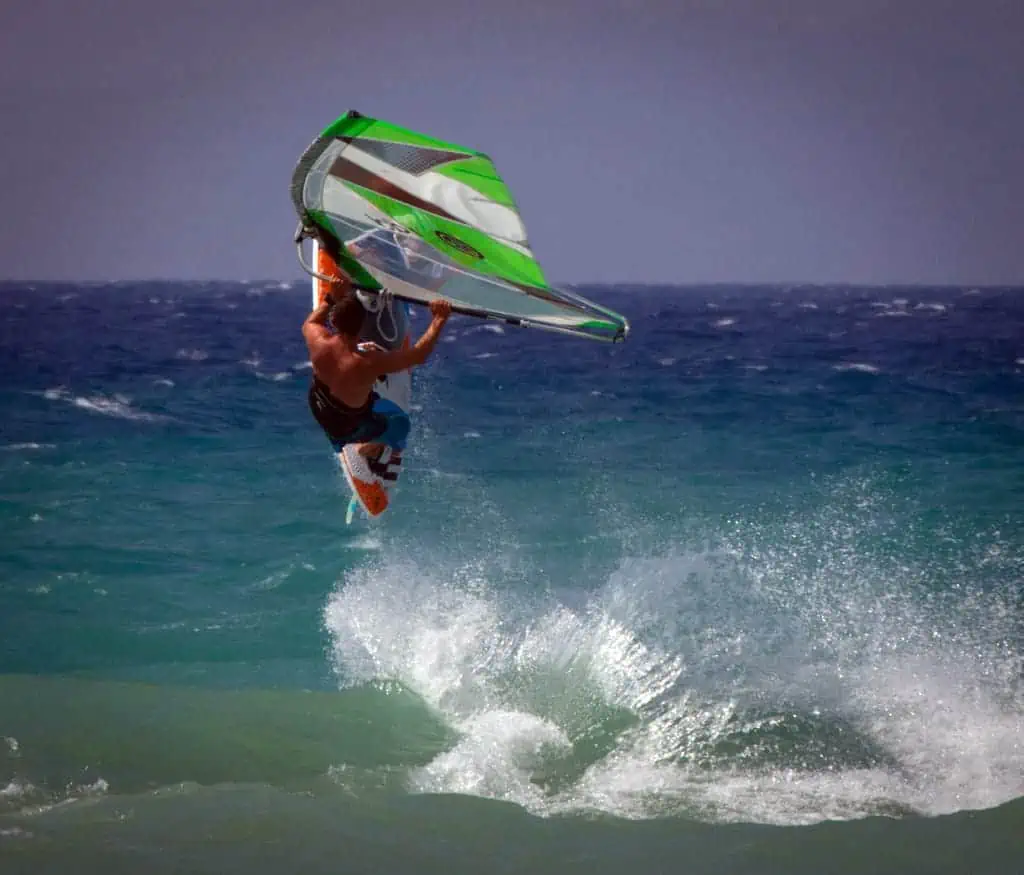
If you have experienced all these things then how windsurfing could be different from actually experiencing life? Do you remember all these drawbacks where you had to “patch your sail” to go in the “sea” again? Do you remember all the times where you wanted to quit windsurfing and all the times in life where you wanted to quit trying “once more’? And you changed your mind and gave space for “one more”?
And the mind… Oh, the mind that with thousands of thoughts tells you what and what not you will do. The mind that will find a thousand reasons to quit and another thousand to keep on “sailing”. What happens when you clear the mind of the garbage? What happens when you focus on windsurfing? Then there comes the magic! But isn’t the same in life? Isn’t the myriads of thoughts that distract you from “sailing” in life and actually living life?
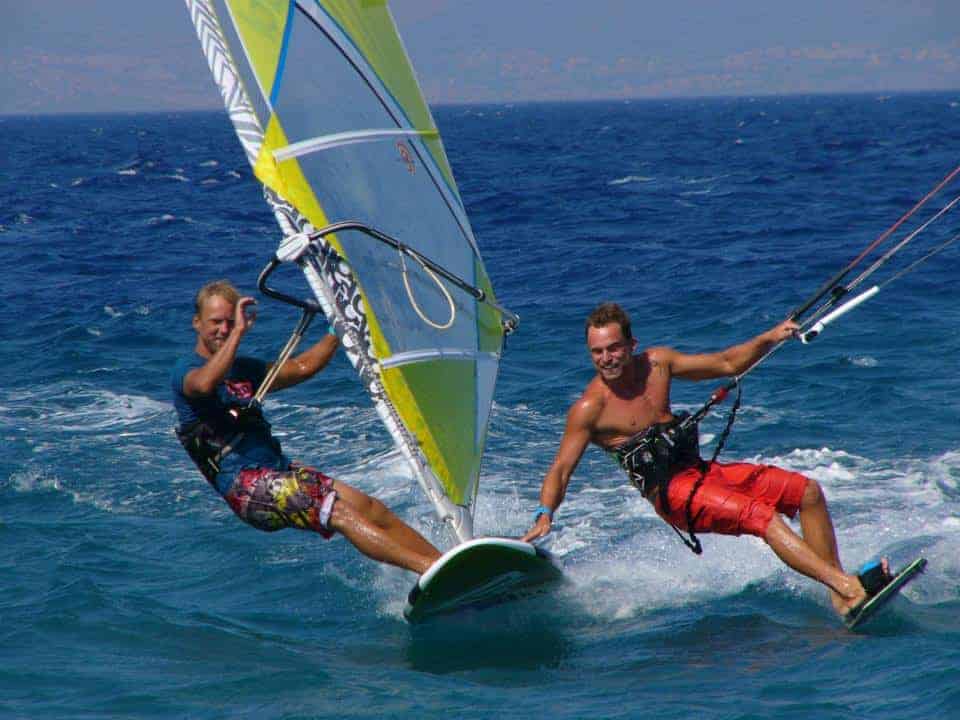
Now, you go through all these things and finally you “achieve” success.. Isn’t the same as in out of water life? Trust me, It is!
And when you achieve success and “sail” fine, there comes something more to learn, to raise your level to new successes and new knowledge. Knowledge to make you sail better.
Windsurfing people, say: windsurfing is not a sport, it’s a way of living. I say, it is life through the filter of windsurfing. When you finally gain the ability to sail without thoughts being in the present and enjoying that freedom which the combination elements of mind, water and sea give isn’t this a kind of “satori”? A revelation of some kind?
If you have ever gone through any meditative training or self observation “practice” all these will sound familiar. If not, jump in!
Happy revelations dudes and enjoy life!
Contact the organizers through this link.

